ِAs I set out to finally write my own story of pain and illness for the first time in my life, I marvel anew at their ability to do this. Because this is very difficult.
This text was originally published by Skin Stories
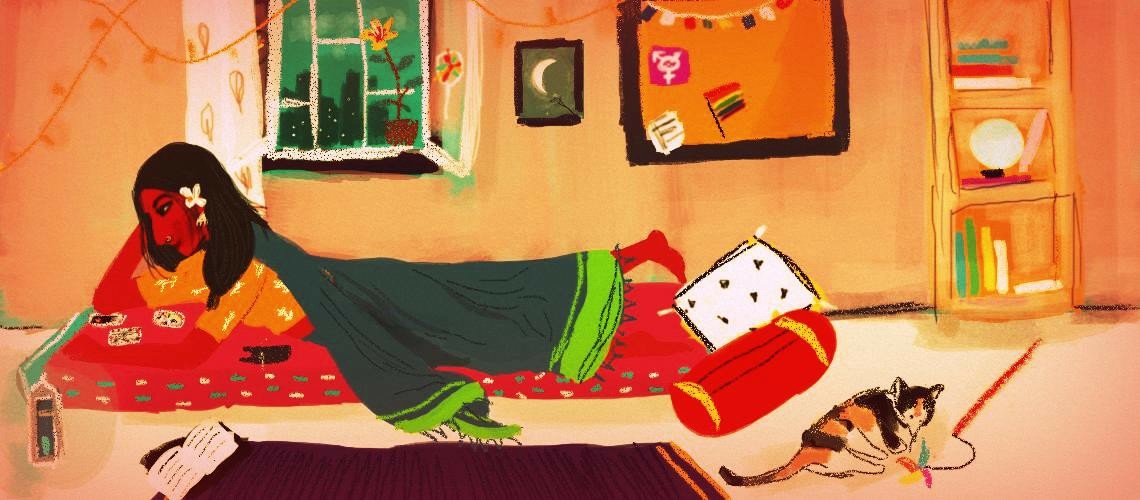
On a bed, a person wearing a sari lies on their stomach, their head propped up on one arm, looking at three tarot cards laid out. There is an open window behind them, lights strung along the orange walls, a picture of a crescent moon and a pin board with a Pride flag. A calico cat is curled up beside a rug on the floor. Credit: Upasana Agarwal.
I have written this story in my head over and over again for nearly nine years. As I write it now, my body baulks at revealing itself to the light, my mind shrinks away. I have already written two different beginnings and deleted them both.
I edit a weekly essay series — this publication — called Skin Stories, which stands at the place where disability, sexuality and gender meet. Every Tuesday, we carry a story about what it is like to be inside the skin of someone who is somehow left out of the River of Everyday Stories. Our writers write unrelentingly and beautifully about inhabiting their bodies and minds, which in the River of Everyday Stories are unimaginatively, often unkindly, labelled ‘Other.’ With patience and wisdom, they persist. They demystify what it is like to live with disability, with difficult mental health, with chronic pain and illness.
And as I set out to finally write my own story of pain and illness for the first time in my life, I marvel anew at their ability to do this. Because this is very difficult.
One of my identities is that I am a young femme person. And one thing young women and femme folks know is how to navigate the River of Everyday Stories carefully, because everything we say can and will be used against us.
We have to behave in certain ways to be taken seriously in any kind of profession. This means not talking about the ways in which our lives are curtailed by structural oppression. Not talking about being ill. Not asking for leave for ‘frivolous’ reasons. Not getting ‘too personal’, which is also sometimes known as ‘seeking attention.’ Not showing emotion, especially not anger and despair.
We are at our most acceptable when we function as perfect automatons, efficient, never revealing our true selves. We make people uncomfortable when we don’t do this. As Sara Ahmed writes, ‘When you expose a problem you pose a problem.’
For those of us who don’t come with security blankets or family connections of any kind, a reputation as ‘emotional’ and ‘unprofessional’ means the difference between having a job and not having one. But there is a limit to which careful silence can be maintained. We find ways to tell. The dams burst, and the River of Story swells.
***
So this is how this story begins. It is past midnight in the middle of an exceptionally difficult week. I am alone in the one room kitchen set I rent in Bombay. I am meant to be writing something that comes naturally to me in conversation — a playlist with some of the ghazals performed by legendary singer Begum Akhtar, who I have listened to every week of my life since I first heard her.
It should be simple enough to write, except that my body and mind are attacking me.
My lower body is clenched from cramping, my neck, back, shoulders and wrists are killing me, and anxious thoughts circle and circle in my mind and begin to peck at the beginnings of whatever I try to say. I give up trying to write. I light candles and tea lights, and clip a red cloth rose to the calendar on my desk. I try to breathe and plant my feet on the ground. Then I shuffle the Tarot deck that recently came into my life through one of my closest friends. I pick three cards at random, and turn them over to reveal their faces. The Star. The Eight of Pentacles. The Lovers.

Three tarot cards on a dark blue background. The card on the left, ‘The Star’, shows a rainbow coloured star radiating light. The card in the middle displays a cobweb with a spider in the centre. The card to the right, ‘The Lovers’, features two Canada geese flying together, with radiating colourful lines in the background. Photo: Shreya Ila Anasuya.
A card of hope. A card related to enhancing one’s craft. A card of union. The question I have been turning over in my mind about my writing is now girded by these stark images. It feels like I have transcended my little life and entered something larger, although it is still past midnight, I am still in pain and considerable discomfort, I have written nothing, and I am alone in my room, far away from every creature I love.
I do not use these cards for divination. I do not believe that they can be. But I believe in a far deeper power that they possess — these archetypal images spring from old stories, old narratives. They are rooted in myth, cultural memory, nature imagery. They do something to me that stories have done to human beings for centuries. They make me feel less alone.
I live with endometriosis, a gynaecological condition that has no known cause or cure.
Mine is a pidgin spirituality. It isn’t rooted in religion, and I reject unidimensional ‘rational’ critiques that have dismissed, laughed away and feared feminised spirituality at the cost of much richness and complexity. It has served me better, in a way, than lurking on web forums with other people like me, who are in pain and in search of answers. They break my heart and often make me feel hopelessly angry. And it has certainly served me better, mentally and emotionally, than the trained professionals who have more often than not dismissed my pain, over and over and over again.
Perhaps this is why the card I’m most drawn to is the High Priestess, third in the Major Arcana, the card of unconscious knowledge, mystery, symbols and dreams.
***
I live with endometriosis, a gynaecological condition that has no known cause or cure. The only thing almost every doctor I have ever seen for the chronic fatigue and pain it brings to my life has been concerned about is whether I want to have children, because it can also make you infertile. And what use am I, as a womb haver, if I don’t push out at least a child or two from my body?
Come with me to the place where I am 19. All my life up to this point has been full of violence. In the home, by a human being who is partly responsible for my physical existence, and who is supposed to love and care for me. Except he doesn’t.
I’m 20. I’m often in pain. My monthly blood, when it comes, brings with it waves of pain that I can hardly stand. Yet every single message the culture around me sends me is that it is supposed to hurt. I am supposed to be in pain. And there is something wrong with me if I can’t stand it.
I’m 21. The most incredible pain grips my right side. It starts whenever it starts, and there is nothing I can do to stop feeling it. My friend takes me to a doctor. He diagnoses a stomach infection, and gives me medicine. It does nothing. My mother takes me to a second doctor. He says I have appendicitis, asks her to get me admitted into a local hospital immediately. I don’t have appendicitis. Finally, a third doctor says I need to get an ultrasound. I do not know yet that this will be the first in years of scans. A lifetime of jelly on my stomach. And always, the person wielding the machine saying, oh, you have cysts.
I’m 21. I have just been told I have something called endometriosis. That the cyst on my right ovary is so large that they’ll have to take it out, otherwise it could put me in danger. I feel like an alien is growing inside of me. A monstrous pregnancy.
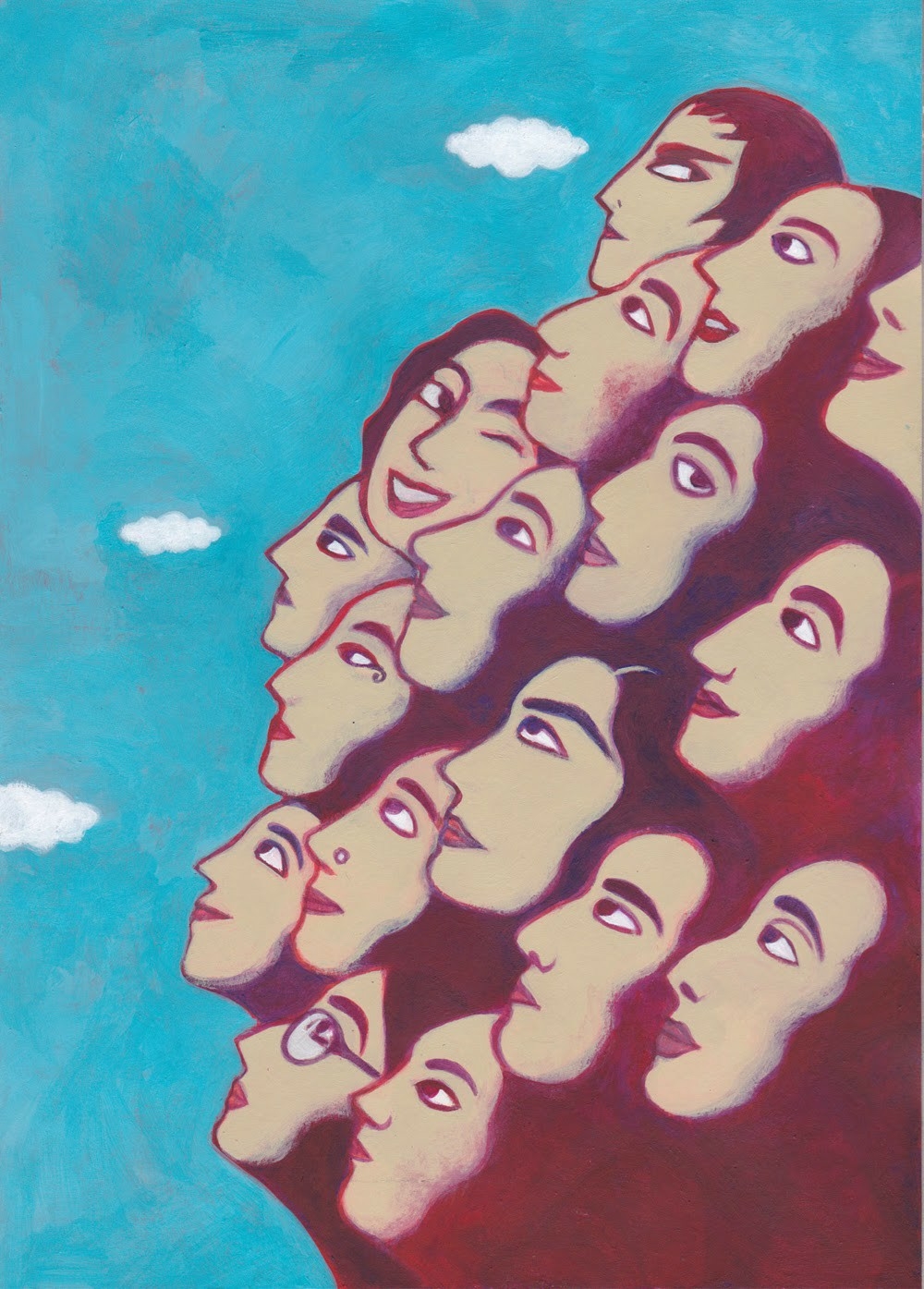
Seventeen faces painted clustered together. They all emerge from the bottom left corner of the image and tilt upwards, only their profiles visible. In the background, the blue sky and white clouds. Some smile, others looks serious, one winks. One wears glasses, another a nose ring. Credit: Extended Sisterhood by Amruta Patil (2013). Reproduced with permission from the artist.
I’m 21. I’ve just had surgery. I’ve woken up from anaesthesia, sobbing, telling my mother repeatedly that I love her. I love you, I love you. I have a wonderful partner with whom I have beautiful sex. As a joke between us, he is growing his facial hair until we can be intimate again. I ask my doctor when I can have penetrative sex again. His face clouds over. ‘Aren’t you unmarried?’
I’m 21. The other doctor sits me down. She says, ‘… you know why you have this disease? You are too masculine. Women are supposed to be docile. That’s why there is too much of the male hormone in your body.’ I laugh tears of disbelief.
I’m 22. I’ve escaped a home that is still unbearable to me, even though the violent parent is no longer in it. I’m in the UK on a scholarship. For the first time in my life my father cannot reach me. I always assumed I would feel elated when I could finally start my life. Instead, I have a breakdown.
A woman at my university who will never know it saves my life. She does this by cackling at me when I worry aloud about submitting my assignments on time because I am suicidal. She helps me get access to a therapist. She tells me the truth: that I mourn the childhood I never had. I realise that escape is not the equal of whatever I had imagined as having one’s own life.
I am numb. I am never not in pain.
I’m 22. The UK medical system is underfunded and overburdened. The night doctors are irritable. I run out of my depression meds sometimes. My therapy sessions have run out. I am numb. I am never not in pain.
I am forced to have a trans-vaginal ultrasound. My face is scrunched up in pain. The man operating the machine tells me he thinks it is endometriosis. But we’ll have to do this again in a minute, as he’s not sure. His supervisor will have to check again. ‘This is really powerful technology, you know.’ I already know I have endometriosis? I’ve had surgery for it? The next appointment is in two months.
I’m 23. 24. 25. 26. I’m working various jobs that take everything out of me. Every doctor’s visit is unbearable, and interchangeable. ‘Are you married?’ ‘Do you want children?’ ‘Why don’t you have children?’ ‘It’s time for you to have children.’ ‘Lie down and spread your legs. This won’t hurt.’ It always hurts. I stop going.
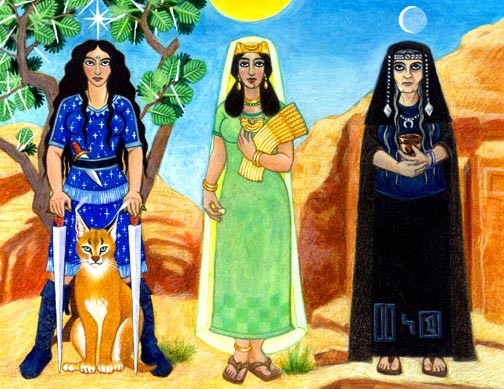
Three figures stand facing us. The figure to the left wears a blue dress spangled with stars, and stands holding two swords, which they rest on either side of a desert lynx, which sits at their feet. A star blazes above their head. In the middle, wearing green, a gold crown and holding golden grain, stands a second figure. The sun shines directly above their head. To the right, dressed in black, stands the third figure. They are holding a cup, and the crescent moon hangs above them. Credit: Al-Uzza, Allat and Manat, the Arabic Triple Goddesses by Thalia Took. Reproduced with permission from the artist.
I’m 27. I finally find a doctor who doesn’t care that I am sexually active and don’t want to get married and don’t think I want children. But the only thing she can give me is birth control pills to shut down my period. The exhaustion and the pain continue. The depression — which is linked to the pill — and the anxiety don’t stop. I don’t know what the pill will do to my body in the long term. I have no choice but to keep taking it.
When she makes sure I am comfortable during our examination, and starts talking about cats to distract me, I start to cry in gratitude.
I am acutely aware that I am able to pay the private hospital in order to see her regularly, no matter how much I may have to scramble for the money. Of the hideousness of being able to do this in a country where women are routinely assaulted in the maternity wards of government hospitals.
I’m 28. For the first time in my life I’ve found a doctor who gives me other options, other than the pill I’ve been on, on and off for eight years. Other pills, especially made for endometriosis she says, or an IUD, which will stop my period for five years. I like her a lot. She asks no questions about marriage or children. She seems to understand the pain I’m in. I choose the other pills. She says they are hard to get. She gives me the card for a guy who can get them for me. Three months later, an acquaintance whose parents are doctors shows me alternatives that are five times cheaper. I feel a deep betrayal.
I’m 28.
‘The Sick Woman is all of the “dysfunctional,” “dangerous” and “in danger,” “badly behaved,” “crazy,” “incurable,” “traumatized,” “disordered,” “diseased,” “chronic,” “uninsurable,” “wretched,” “undesirable” and altogether “dysfunctional” bodies … who have been historically pathologized, hospitalized, institutionalized, brutalized, rendered “unmanageable,” and therefore made culturally illegitimate and politically invisible.’ — Johanna Hedva, Sick Woman Theory
I was born under the almost full moon. I sometimes joke that this is how I feel, frustratingly close, but never enough. If I work a full time job (or, more realistically in the fields where I can work, a job that more often than not requires me to work days, evenings and weekends) I can’t have many things that make me feel loved and sane, including the feeling that I belong to a community. If I want a place where I can live by myself, I cannot have my cats. If I use up my spoons to cook, or to see a friend, or to take a dance lesson, I have to contend with the energy that cannot be directed to anything else I may want or need equally intensely.
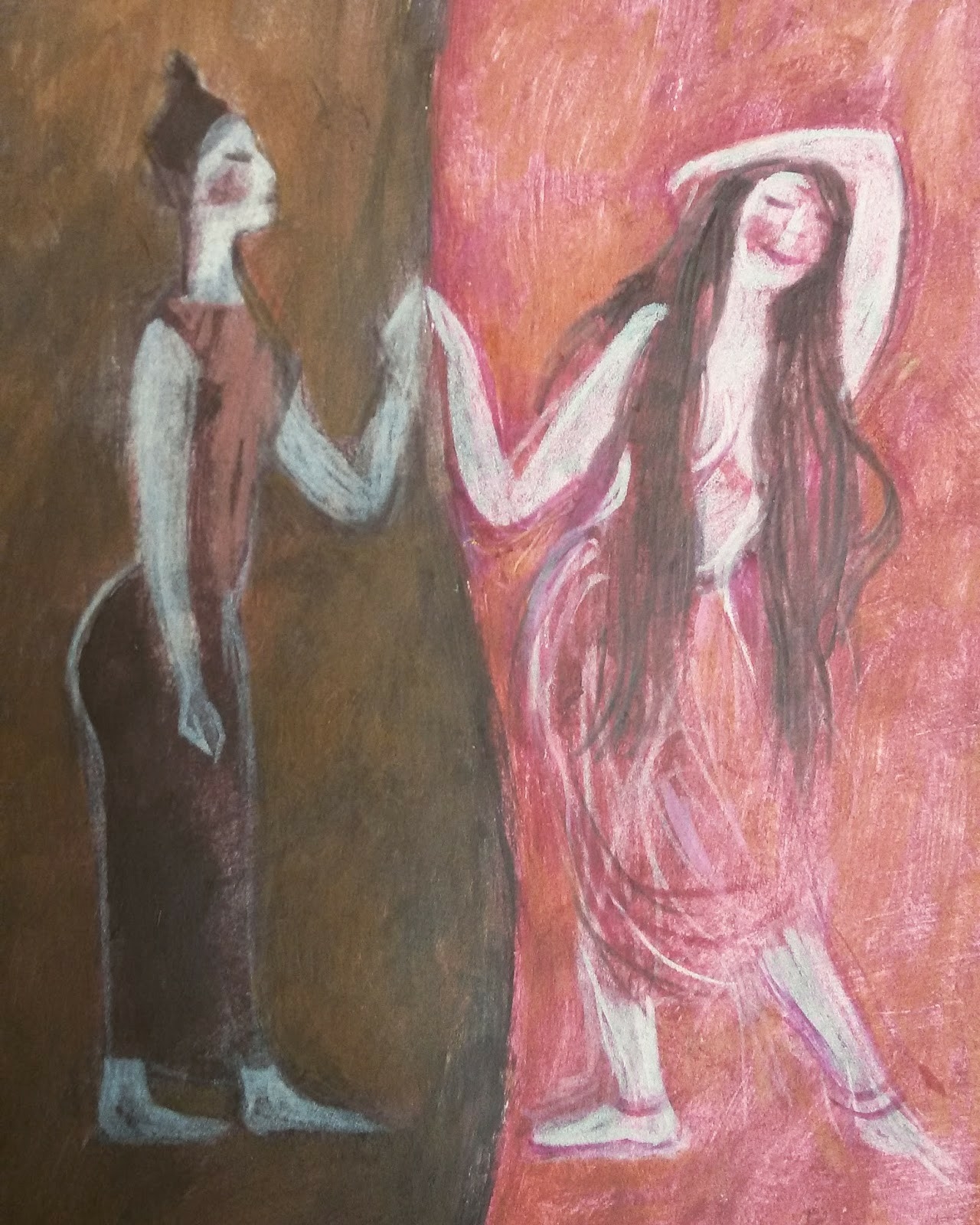
The painting depicts two figures. To the left, against a dark brown background and wearing brown clothing and an upright stance, is a figure with their hair in a high bun. They touch hands with a figure to the right, against a rosy background, whose long hair is undone, and who strikes a pose of abandon. Credit: Neti Neti (Not This, Not This) and Iti Iti (And This, And This) by Amruta Patil (2015). Reproduced with permission from the artist.
But I am always looking for the moment of intimacy unmediated by pain, for a life that will accommodate my many human desires. And this is only my experience, in which I can wield certain kinds of privilege that millions of other people in the same position cannot.
And as another International Working Women’s Day creeps up on us, we push past the sinister pinkwashing it is shrouded in, and reiterate that this desire for more is political.
To be seen as employable and not to be dismissed because our bodies have different demands, and because we make these demands known. To have our pain acknowledged for its own sake, not via the lens of reproductive ability. To be seen as deserving of research that can look towards finding a cause, and a cure.
Following Johanna Hedva, whose iconic essay I quote above, I join legions of sick, passionate, tired, ‘unlikeable’, infuriating, infuriated, driven, exhausted, ‘difficult’, resilient, angry, ‘hysterical’, loving, fiery, inventive bodies as we raise up our arms and reach towards more. Towards the hugeness of the astounding full moon at its perigee.
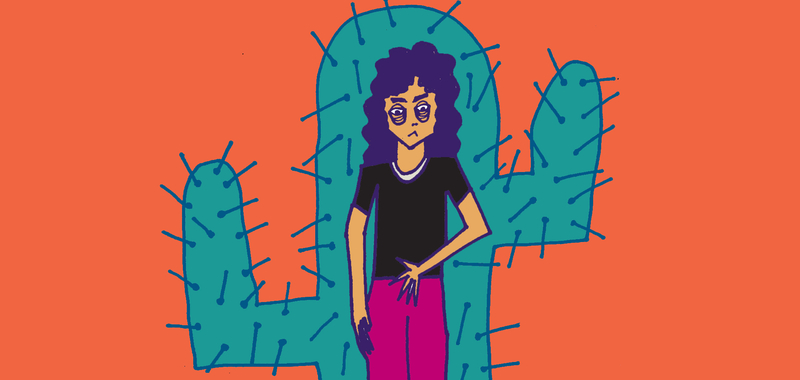
Add new comment